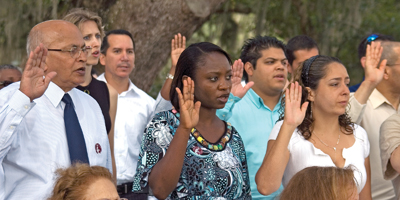
 CHARLESTON—Barbara Martinez was just a baby when her mother bundled her up and fled the dictatorship of Fidel Castro in Cuba. The family crossed the ocean by boat, just as pilgrims did hundreds of years ago, seeking freedom and a better life.
CHARLESTON—Barbara Martinez was just a baby when her mother bundled her up and fled the dictatorship of Fidel Castro in Cuba. The family crossed the ocean by boat, just as pilgrims did hundreds of years ago, seeking freedom and a better life.
Her life here included going to school, getting married and raising a family, Martinez said. But it wasn’t until her 40th birthday that she decided to become a naturalized citizen of her adopted country.
“I decided it was time for me to step up to the plate,” she said. “I’ve been raised here, worked here, it’s time to be a citizen. I’m so glad that I did it.”
Martinez was one of 63 people who took the oath of citizenship of the United States of America during a swearing in ceremony at Middleton Place on July 2.
Mayor Joseph P. Riley, keynote speaker, commented on the historic significance of the setting, noting that Arthur Middleton was one of the signers of the Declaration of Independence and his plantation home served as a scenic backdrop.
Standing at a podium, Riley spoke to a crowd blessed by a cool breeze as they sat under the shade of oaks draped in moss.
“We are a nation of immigrants,” the mayor said.
He spoke of those who first came over in the 1800s from Germany, Ireland and Italy, and the more recent wave from Africa, Asia, and Central and South America.
“The reality of America as it is now … has been made more so because we have been honored to welcome new citizens to join us,” Riley said, adding that those citizens bring new ideas, cultures, aspirations and an enhanced appreciation for what this country offers.
Haiqing Liu Kaczkowski said she knew even as a child growing up in China that one day she wanted to be part of “the land of the free and the home of the brave.”
She had a good job as an associate professor when she received a visa to attend the University of Florida, where she earned her doctorate in coastal engineering. She said she wants to use her education to help her new country.
Kaczkowski radiated happiness as she spoke about the ceremony, describing it as touching and memorable.
She acknowledged that she sometimes encounters negative reactions from people as immigration continues to escalate as a hot-button issue.
 Officials at the ceremony said it is important to understand the difference between legal and illegal immigration, and to welcome our new citizens.
Officials at the ceremony said it is important to understand the difference between legal and illegal immigration, and to welcome our new citizens.
The U.S. Bishops have called on Catholics to demonstrate compassion and charity in all areas of immigration.
Bishop John C. Wester of Salt Lake City, Chairman of the U.S. Bishops’ Committee on Migration, said they support comprehensive immigration reform that takes into account the rights of a country to secure its borders and the rights of people to emigrate to support themselves and their families.
Bishops across the country speak of the broken immigration system and the need to reform it so that basic moral principles, founded on the inherent, God-given dignity of the human person, are maintained.
They ask, through the Justice for Immigrants campaign, for “legislation that keeps immigrant families together, adopts smart and humane enforcement policies, and ensures that immigrants without legal status register with the government and begin a path toward citizenship.”
The plaque on the Statue of Liberty entreats: “Give me your tired, your poor/Your huddled masses yearning to breathe free.”
Those masses are still out there.
According to U.S. Citizenship and Immigration Services, they have 130 Application Support Centers that take 8,000 fingerprints every day. The agency also process 30,000 applications for immigrant benefits and answers in-person inquiries from 19,000 visitors — daily.
Every year, a portion of those make it to American citizenship.
During the week of July 4, 55 ceremonies were held across the country, with an estimated 3,800 people becoming U.S. citizens.
Jerri Adair, field office director for the Bureau of Citizenship and Immigration Services, said each applicant undergoes an intense background investigation.
They must also read, write and speak English, and demonstrate knowledge of U.S. civics, past and present.
Showing that he has a firm grasp of English and civics, Mauricio Ottich spoke about his home in Bolivia and why he wanted to be a U.S. citizen.
“I’d like to have the right to vote, and make my voice be a difference for the future and how it affects my family,” Ottich said.
He said there were no wars or strife in Bolivia, but neither were there opportunities. When he was given the chance to attend school at Providence College in Rhode Island, he leapt at it.
“I’ve really appreciated the opportunity to be educated and to be free,” he said.
Could you pass the Citizenship Test?
There are easy questions, such as:
Questions you might miss:
To view the entire test, visit www.usgovinfo.about.com/library/blinstst_new.htm. |
